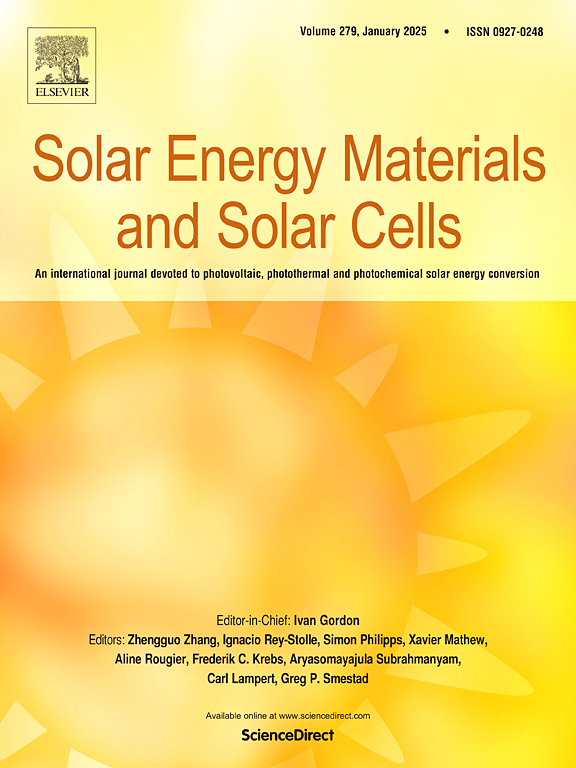真空退火钼背触点对提高CZTSSe薄膜性能和器件的多方面好处
IF 6.3
2区 材料科学
Q2 ENERGY & FUELS
引用次数: 0
摘要
Cu2ZnSn(SxSe1−x)4 (CZTSSe)薄膜太阳能电池(TFCS)具有低成本、丰度和无毒性等优点,正在成为可持续能源生产的有利材料。尽管CZTSSe太阳能电池取得了重大进展,但由于背接触材料和界面层形成等因素,优化其性能仍然具有挑战性。钼(Mo)由于其坚固性和与吸收层的相容性,通常用作背接触材料。然而,Mo的功函数对其沉积条件非常敏感,这会影响器件的开路电压(Voc)和电阻。本研究探讨了通过真空退火等沉积后处理优化Mo功函数对提高Mo薄膜电学和形态性能的影响。此外,还研究了Mo/CZTSSe界面Mo(S,Se)2层的生长及其对器件性能的影响。因此,我们证明Mo沉积后退火可以显著改善CZTSSe太阳能电池的功函数,减少界面层厚度,提高其整体光伏性能。我们的研究结果表明,优化的Mo背接触导致了功率转换效率的提高,mo_va处理薄膜的效率达到7.7%,而溅射Mo薄膜的效率为0.71%,突出了背接触优化在基于cztse的光伏电池中的关键作用。本文章由计算机程序翻译,如有差异,请以英文原文为准。

Manifold benefits of vacuum annealed molybdenum back contact for enhanced CZTSSe thin film properties and device
Cu2ZnSn(SxSe1−x)4 (CZTSSe) thin-film solar cell (TFCS) are emerging as favourable materials for sustainable energy production, offering advantages such as low cost, abundance, and non-toxicity. Despite the significant progress in CZTSSe solar cells, optimizing their performance remains challenging due to factors like back contact material and interfacial layer formation. Molybdenum (Mo) is commonly used as a back contact material due to its robustness and compatibility with the absorber layer. However, the work function of Mo is highly sensitive to its deposition conditions, which can influence the device's open-circuit voltage (Voc) and resistance. Our study investigates the impact of Mo work function optimization through post-deposition treatments, such as vacuum annealing, to enhance the electrical and morphological properties of Mo films. Additionally, the growth of Mo(S,Se)2 layers at the Mo/CZTSSe interface and its influence on the device's performance is studied. We thereby demonstrate that post-deposition annealing of Mo can significantly improve the work function, reduce interfacial layer thickness, and enhance the overall photovoltaic performance of CZTSSe solar cells. Our findings reveal that the optimized Mo back contact results in an improved power conversion efficiency, with Mo_VA-treated films achieving 7.7 % efficiency compared to 0.71 % efficiency for as-sputtered Mo films, highlighting the critical role of back contact optimization in CZTSSe-based photovoltaics.
求助全文
通过发布文献求助,成功后即可免费获取论文全文。
去求助
来源期刊

Solar Energy Materials and Solar Cells
工程技术-材料科学:综合
CiteScore
12.60
自引率
11.60%
发文量
513
审稿时长
47 days
期刊介绍:
Solar Energy Materials & Solar Cells is intended as a vehicle for the dissemination of research results on materials science and technology related to photovoltaic, photothermal and photoelectrochemical solar energy conversion. Materials science is taken in the broadest possible sense and encompasses physics, chemistry, optics, materials fabrication and analysis for all types of materials.
 求助内容:
求助内容: 应助结果提醒方式:
应助结果提醒方式:


